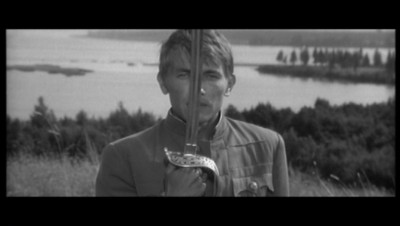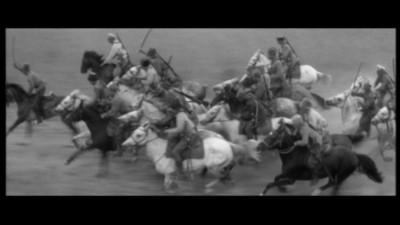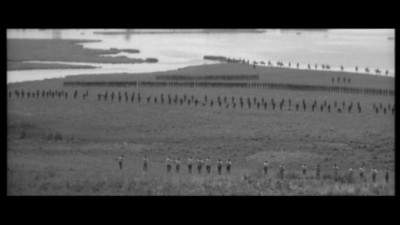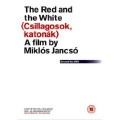| Reviews & Columns |
|
Reviews DVD TV on DVD Blu-ray 4K UHD International DVDs In Theaters Reviews by Studio Video Games Features Collector Series DVDs Easter Egg Database Interviews DVD Talk Radio Feature Articles Columns Anime Talk DVD Savant Horror DVDs The M.O.D. Squad Art House HD Talk Silent DVD
|
DVD Talk Forum |
|
|
| Resources |
|
DVD Price Search Customer Service #'s RCE Info Links |
|
Columns
|
|
|
Red and the White, The

The Red and the White occurs on a single day in 1919. The Tsarist "Whites" are battling the Bolshevik "Reds" for control of a fluid war zone between the Volga River and an abandoned monastery.
Completed in 1967, The Red and the White followed on the heels of Jancsó's prior two critically successful period martial films, My Way Home (1965) and the The Round-Up (1966), and further solidified his reputation as an auteur of intricately-choreographed dolly shots that fluidly move from widescreen action to intimate close-ups and back in single long takes.

The Red and the White can be a difficult film on a first viewing because it defies the conventions of a traditional war picture. There are no clearly defined protagonists to cheer or antagonists to jeer. The Whites are slightly better dressed, but otherwise nearly indistinguishable from the Reds. Both sides occasionally exhibit compassion for prisoners and non-combatants, but both also can be cruel, even to their own comrades. The Red and the White promotes further confusion by presenting a fluid war zone without front lines, filled with combatants who are one moment victorious and the next dead. The camera frequently follows a contingent of Reds only to see them killed, captured, or routed by a counter-party of Whites who will in turn be killed, captured, or routed. Time and again to wonder if the present group of characters on the screen will emerge as the main protagonists only to have them killed in turn was an eyeopener for me about my genre preconceptions.
Presentation
The Red and the White has been released from the UK-based boutique DVD label Second Run on a single dual-layered DVD which is PAL-encoded but not region restricted.
Video:
The Red and the White is presented in a 2.35:1 anamorphic scope. The image is clean but frequently very soft, looking decidedly inferior to the other two Jancsó releases from Second Run.
Audio:
The monaural Hungarian-language audio sounds muffled. Again as with the video, the audio is inferior to that found on the other two Jancsó releases from Second Run. The removable English-language subtitles are well translated and appropriately sized, paced, and placed.
Extras:
This disc includes Message of Stones: Budapest (1994), a 54-minute made-for-Hungarian-TV documentary by Miklós Jancsó about Budapest's close-knit Jewish community. Also included is a twenty-page booklet with a Miklós Jancsó interview conducted by Kinoeye editor-in-chief Andrew James Horton.
Final Thoughts:
In The Red and the White, Miklós Jancsó critiques both war and the conventions of the war film genre. There are no gallant heroes, no side to root for, nor really even any protagonists. There is no mission to be accomplished other than perhaps a momentary victory through grinding attrition, and thus no narrative arc to frame the film. Though bereft of comedy, as an indictment of war and the war film genre, The Red and the White is as seminal as Stanley Kubrick's Dr. Strangelove or: How I Learned to Stop Worrying and Love the Bomb (1964).
Highly recommended.

|
| Popular Reviews |
| Sponsored Links |
|
|
| Sponsored Links |
|
|
| Release List | Reviews | Shop | Newsletter | Forum | DVD Giveaways | Blu-Ray | Advertise |
|
Copyright 2024 DVDTalk.com All Rights Reserved. Legal Info, Privacy Policy, Terms of Use,
Manage Preferences,
Your Privacy Choices | |||||||












